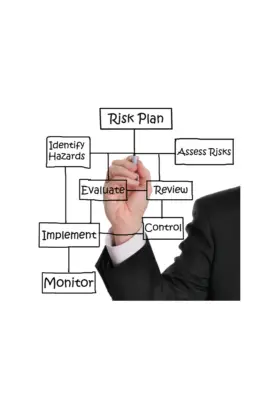Operational risk management is a critical part of any organization, but it can be challenging to know where to start. Without a process, it can be difficult to identify and mitigate potential risks. Not only can this lead to financial losses, but it can also put your employees and customers at risk.
Every day, your organization faces potential risks that could impact its ability to function correctly. These risks can come from various sources, such as natural disasters, human error, or technological failures.
By following the best steps of an effective operational risk management process, you can ensure that your organization is protected from potential risks. You can create a process that helps you identify and mitigate potential risks before they cause damage.
If you’re responsible for operational risk management in your organization, then it’s vital to have a process in place that helps you identify and mitigate potential risks. This blog post will outline the best steps of an effective operational risk management process.
Differentiate erm with Operational Risk Management
- ERM is a holistic framework for managing risk, while operational risk management is a narrower focus on risks related to the day-to-day operations of an organization.
- ERM includes all types of risks that could impact an organization, while operational risk management typically focuses on specific types of risks such as financial, safety, and compliance risks.
- ERM is intended to help organizations better understand and manage their overall risk exposure. In contrast, operational risk management is focused on mitigating specific risks that could hurt business operations.
What is a Process in Operational Risk?
Processes in operational risk can include hiring and firing employees, acquiring and disposing of assets, and conducting business operations.
It’s essential to manage operational risks, as they can significantly impact the organization. Processes should be designed to identify potential risks and then develop plans to mitigate those risks. Risks can vary from one organization to another, so it’s important to tailor processes specifically to the organization’s needs.
Types of Operational Risk
- Business interruption risk includes risks to the continuity of business operations, such as fire, natural disaster, power outage, telecommunications failure, or loss of key personnel.
- Financial risk includes losses from financial instruments such as foreign exchange rates, interest rates, and credit risks.
- Regulatory risk includes changes in laws and regulations that may impact a company’s ability to do business or increase costs.
- Reputational risk includes damage to a company’s reputation caused by unfavourable news media coverage, activist investors, or product recalls.
- Cybersecurity risk – this includes the potential for data breaches and cyber attacks that could impact a company’s systems or customers
What is an RCSA in Operational Risk
RCSA stands for “risk control self-assessment.
RCSAs are risk management tools used by organizations to help identify, assess, and control the risks that could impact their ability to achieve their objectives.
RCSAs typically involve a review of an organization’s processes, policies, procedures, and practices to identify any areas where improvements can be made regarding risk management.
RCSA is an assessment of operational risk planned, structured, and performed consistently. It is based on the business process and activities within an organization. Designed to identify, measure, and manage operational risks, used to inform decision making about the allocation of resources to address operational risks.
Senior management needs to assess and monitor overall operational risk exposures.
What are the 3 levels of Orm?
- Strategic: This level focuses on high-level risks that could significantly impact the organization as a whole. It includes risks such as losing key customers or business partners, natural disasters, and significant system failures.
- Tactical: This level deals with risks that could impact specific operations within the organization. It might include a supplier going out of business, fraud in a particular department, or an IT outage.
- Operational: This is the lowest level and is concerned with day-to-day risks affecting individual employees or processes. Examples might include losing a laptop or getting sick while travelling for work.
Steps of an Effective Operational Risk Management Process
The key to managing operational risks lies in identifying them. It means understanding what your business does and where those potential issues could arise from – both internally and externally with clients or suppliers, for example.
There is no one-size-fits-all approach when it comes down to this problem-solving; different companies will have varying needs based on their specific industries, so proper consideration should be given before implementing anything federally across an organization’s entire workforce.
1. Implement a risk management policy and procedures manual
To protect organizations from the potential risks of their business, managers need to implement a well-thought-out risk management policy and procedures manual. It will help organizations stay disciplined in approaching risk management to understand that specific actions could lead down dangerous pathways.
The policy and manuals need to be reviewed annually to ensure that they are still current. A “manual” is an internal blueprint for organizations’ risk management efforts. A manual should contain all the necessary internal policies, procedures, and guidelines to manage risk throughout the enterprise properly.
2. Assign a risk management team and roles
Every organization needs a risk management team. This team will make sure that all the activities related to risk management are carried out effectively in the organization.
The goal of this group, or any specific project’s risks, are to deal exclusively with risk assessments. The team will be responsible for carrying out risk management activities.
3. Define the risk management process
The organization needs to have a defined risk management process that is documented. The risks might borrow from ISO 31000:2018 and COSO ERM standards, among others.
The ISO 31000:2018 and COSO ERM standards are an excellent place to start for organizations looking at how they should handle risk. These documents offer many best practices that can help you identify opportunities in your company’s operations create plans of action when risks arise.
4. Identify, assess, and prioritize risks
The process of identifying and prioritizing operational risks is an important one. This can be done annually or according to your company’s ERM Framework. The step must happen regularly to make informed decisions when faced with unexpected events.
Risk identification, assessment & prioritization are integral parts of managing any business.

5. Implement controls to mitigate identified risks
An organization must implement controls to minimize their consequences to mitigate operational risks. It can be done by implementing a combination of internal controls and risk mitigation plans.
Risk mitigation plans are developed to help organizations reduce the impact of a particular identified risk, which is confirmed as a threat to one of the organization’s goals. In fact, according to the main conditions that play into determining a risk, it must impact the organization or its goals. The function of risk mitigation plans is to minimize the impact of identified risks, so it is preferable to implement these plans before an incident.
There are two types of risks mitigation plans: physical and non-physical. Physical measures are things you can see and touch, like having a fire extinguisher in your office. Non-physical measures are things like having insurance in case something happens.
6. Track and report on progress
The organization needs to track and report on the operational risk assessment progress. It is essential for risk assessments that are done infrequently.
Track the progress of key operation risks, several audits performed, issues identified, risk mitigation measures implemented. Include audit and monitoring plans in the report.
The mitigation measures identified should include the organization’s plan for and responsibility for ensuring the implementation of those measures. The organization’s risk management framework (RMF) will dictate several aspects of this plan such as frequency of execution (e.g., annual or quarterly), who is responsible for carrying out the mitigation measures, what will be done to monitor the effectiveness of those mitigations (e.g., risk monitoring reports), and how long a mitigation measure may remain in place before it is reassessed.
7. Review and update the risk management process as needed
Periodically review the risk management process to make sure it is still relevant. There are always new risks that need to be included or old risks that may not be as significant as they once were. An excellent way to do this is to regularly review the risk management process against the current business environment.
How Do You Mitigate Operational Risk
- Implement standard operating procedures and protocols,
- Document all processes and procedures.
- Conduct operational risk assessments.
- Train employees on safety procedures and emergency response plans.
- Establish lines of communication for reporting emergencies or safety incidents.
- Continually update emergency response plans in the event of changes to the business or facility.
- Maintain a well-organized and up-to-date IT infrastructure,
- Use data backup and recovery procedures to protect your data.
- Restrict access to confidential information to authorized personnel only.
- Implement a system of change management controls to ensure that all changes made to your IT systems are adequately tested and authorized.
- Educate your employees on how to recognize and report suspicious activity or incidents.
- Periodically review your security policies and procedures to ensure that they are still adequate.
Significance of Operational Risk Management to Business
- Operational risk management is essential to business success as it helps protect a company’s finances, operations, and employees.
- By identifying and mitigating operational risks, businesses can avoid costly financial losses and improve overall performance.
- Operational risk management helps organizations improve their crisis response planning, ensuring that they are better prepared for potential emergencies.
- Employees are also protected when businesses implement effective operational risk management practices, as these practices help create a safe and secure working environment.
Operational Risk Management Tools and Techniques
- Risk Management Planning: the development and implementation of risk management policies and procedures.
- Risk Assessment: a systematic process of analyzing potential risks to an organization.
- Risk Identification: the identification of potential risks to an organization.
- Risk Evaluation: the evaluation of identified risks to determine their severity and likelihood of occurrence.
- Risk Response Planning: the formulation of plans for dealing with identified risks, including mitigation measures, contingency plans, and acceptance plans.
- Risk Monitoring and Review: regular monitoring of risk response plans and the ongoing evaluation of risk exposure levels.
Conclusion
There are many steps to an effective operational risk management process. We’ve outlined the seven most important ones here, but it is critical that you understand each one in detail.
The best way to mitigate risk is by implementing a successful operational risk management process. There are seven steps in an effective operational risk management process, and each one of them will help you create a workable plan for your business.
Operational risk management is an essential aspect of any business, especially in today’s digital economy. To help you get started on the right path with your operational risk management process, we’ve outlined some best practices that have been proven to work time and again by companies just like yours. If you need a hand implementing these steps or want more information about mitigating risks for your company, reach out!

Chris Ekai is a Risk Management expert with over 10 years of experience in the field. He has a Master’s(MSc) degree in Risk Management from University of Portsmouth and is a CPA and Finance professional. He currently works as a Content Manager at Risk Publishing, writing about Enterprise Risk Management, Business Continuity Management and Project Management.

